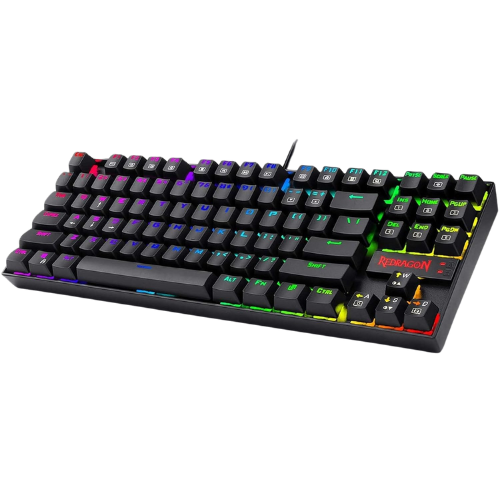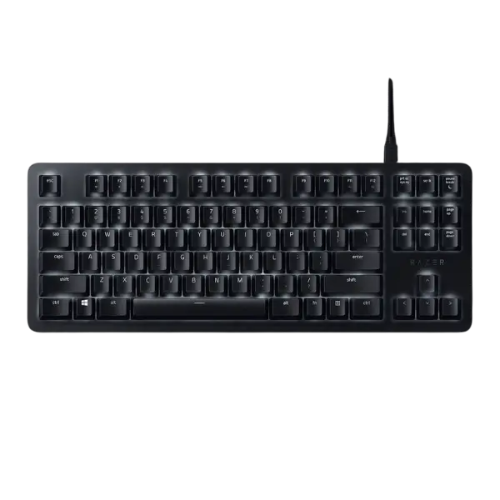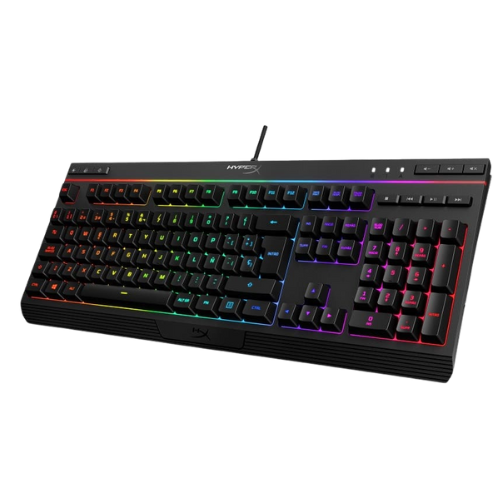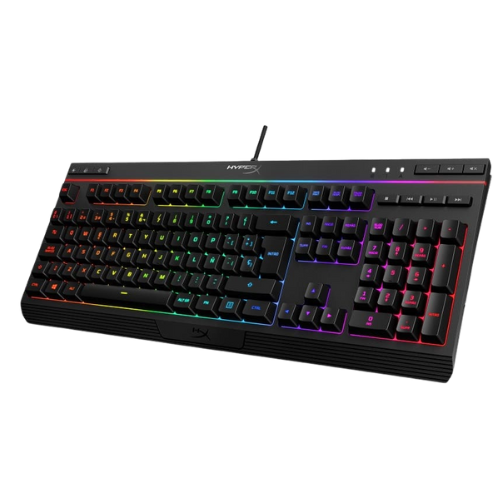So, mechanical vs. membrane gaming keyboards, which way, gamer, in 2025?
Just recently I was discussing with a friend, do I really need another keyboard. We concluded that, of course, I don’t need it per se, but I sure am going to get one.
As a gamer, choosing the right keyboard can be a crucial decision. Both membrane and mechanical keyboards have their own unique advantages and disadvantages, and understanding the differences between them is essential to making an informed decision. In this blog, I’ll go deep into this topic, exploring their characteristics, pros, and cons to help you determine which one is right for you.
If you’re interested in this topic from a perspective of a Shopify seller, read this post blog.
Mechanical vs. Membrane Gaming Keyboards: Summary
Mechanical Keyboards:
- Offer a more tactile and responsive typing experience with individual switches under each key
- Provide better durability and customization options, but are generally more expensive
- Suitable for gamers and typists who value precision and speed
Membrane Keyboards:
- Use a single layer of conductive material under the keys, providing a softer and less tactile typing experience
- Are generally more affordable and quieter than mechanical keyboards, but may lack durability and customization options
Ultimate Decision:
- Choose a mechanical keyboard if you’re a serious gamer or typist who values precision, speed, and customization
- Choose a membrane keyboard if you’re on a budget or prefer a quieter, more affordable typing experience
Mechanical Keyboards
Mechanical keyboards feature individual switches under each key, which provide a tactile and audible feedback when pressed. These switches are designed to last for millions of keystrokes, making them extremely durable and resistant to wear and tear.
Pros:
- Better tactile feedback: Mechanical keyboards offer a more precise and responsive typing experience, allowing gamers to execute complex commands quickly and accurately.
- Customizability: Mechanical keyboards can be customized with different switch types, keycap designs, and backlighting options to suit individual preferences.
- Durability: With a lifespan of up to 50 million keystrokes, mechanical switches can withstand the rigors of intense gaming sessions.
- N-key rollover: Mechanical keyboards can handle multiple key presses simultaneously, eliminating ghosting and lag.
Cons:
- Higher cost: Mechanical keyboards are generally more expensive than membrane keyboards, especially high-end models with advanced features.
- Loud and clicky: Mechanical switches can be noisy, which may be distracting in quiet environments or during late-night gaming sessions.
- Heavier and bulkier: Mechanical keyboards tend to be heavier and larger than membrane keyboards, making them less portable.
Membrane Keyboards
Membrane keyboards, also known as “rubber dome” keyboards, feature a single layer of conductive material beneath the keys. When a key is pressed, it makes contact with the membrane, registering the input.
Pros:
- Affordability: Membrane keyboards are generally cheaper than mechanical keyboards, making them a more accessible option for budget-conscious gamers.
- Quieter and lighter: Membrane keyboards are often quieter and more compact than mechanical keyboards, making them ideal for travel or quiet environments.
- Easy to clean: Membrane keyboards are less prone to dust and dirt accumulation, making them easier to clean and maintain.
Cons:
- Less tactile feedback: Membrane keyboards can feel mushy and unresponsive, leading to typing errors and fatigue.
- Limited customizability: Membrane keyboards offer limited customization options, which may not appeal to gamers who value personalization.
- Lower durability: Membrane keyboards are more prone to wear and tear, with a shorter lifespan than mechanical keyboards.
Which One is Right for You?
Ultimately, the choice between a mechanical and membrane keyboard comes down to your personal preferences, gaming style, and budget. Here are some guidelines to help you decide:
- Competitive gamers: If you’re a professional gamer or compete in esports tournaments, a mechanical keyboard is likely the better choice. The tactile feedback, customizability, and durability offered by mechanical keyboards can provide a competitive edge.
- Casual gamers: If you’re a casual gamer or prefer a more relaxed gaming experience, a membrane keyboard may be sufficient. Membrane keyboards are often more affordable and quieter, making them suitable for everyday use.
- Budget-conscious gamers: If you’re on a tight budget, a membrane keyboard may be the more affordable option. However, consider investing in a mid-range mechanical keyboard if you value the benefits they offer.
In conclusion, both mechanical and membrane keyboards have their strengths and weaknesses. By understanding the differences between these two types of keyboards, you can make an informed decision that suits your gaming needs and preferences.
- Budget: Redragon K552 (Under $50)
- Features:
- Mechanical switches (Outemu Blue)
- 104-key layout
- Customizable backlighting with 12 modes
- Media controls
- Rating: 4.5/5 (Amazon), 4.5/5 (Newegg)
- Number sold: Over 1 million units
- Why it’s good: The Redragon K552 offers great value for its price, with mechanical switches, customizable backlighting, and a comfortable ergonomic design.
- What’s missing: The Outemu Blue switches may not be as durable as Cherry MX switches, and the keyboard’s build quality could be better.
Logitech G Pro X
- Mid-range: Logitech G Pro X (Around $100)
- Features:
- Romer-G mechanical switches (Tactile or Linear)
- 104-key layout with customizable F-keys
- 1ms report rate and 1000Hz polling rate
- Customizable lighting with 16.8 million colors
- Compact tenkeyless design
- Rating: 4.7/5 (Amazon), 4.8/5 (Newegg)
- Number sold: Over 500,000 units
- Why it’s good: The Logitech G Pro X offers a great balance of performance, features, and price. The Romer-G switches are fast and responsive, and the customizable lighting is impressive.
- What’s missing: Some users may find the compact tenkeyless design too small, and the keyboard’s software can be finicky.
Razer BlackWidow Lite
- Mid-high end: Razer BlackWidow Lite (Around $150)
- Features:
- Razer proprietary mechanical switches (Orange or Yellow)
- 104-key layout with customizable macro keys
- 1000Hz polling rate and 1ms report rate
- Customizable Chroma lighting with 16.8 million colors
- Rating: 4.6/5 (Amazon), 4.7/5 (Newegg)
- Number sold: Over 300,000 units
- Why it’s good: The Razer BlackWidow Lite offers a great gaming experience with fast and responsive switches, customizable macro keys, and impressive Chroma lighting.
- What’s missing: The Razer proprietary switches may not be as durable as Cherry MX switches, and the software can be resource-intensive.
WASD Code 104
- High-end: WASD Code 104 (Around $250)
- Features:
- Cherry MX Brown mechanical switches
- 104-key layout with customizable F-keys
- Programmable macro keys with 3-layer key mapping
- USB passthrough and 2-port USB hub
- Durable construction with anodized aluminum frame
- Rating: 4.8/5 (Amazon), 4.9/5 (Newegg)
- Number sold: Over 100,000 units
- Why it’s good: The WASD Code 104 offers a premium typing experience with Cherry MX Brown switches, customizable macro keys, and a durable construction.
- What’s missing: The keyboard’s software can be complex, and the price may be out of reach for some users.
Anne Pro 2
- Premium: Anne Pro 2 (Around $350)
- Features:
- Cherry MX Switches (Blue, Brown, or Red)
- 104-key layout with customizable F-keys
- Wireless connectivity with 8-hour battery life
- Compact tenkeyless design with anodized aluminum frame
- Programmable macro keys with 3-layer key mapping
- Rating: 4.9/5 (Amazon), 4.9/5 (Newegg)
- Number sold: Over 50,000 units
- Why it’s good: The Anne Pro 2 offers a premium typing experience with Cherry MX switches, wireless connectivity, and a compact tenkeyless design.
- What’s missing: The price is quite high, and some users may find the compact design too small.
- Budget: Redragon K617 (Under $20)
- Features:
- Membrane switch technology
- 104-key layout
- 12 multimedia keys
- Adjustable backlighting with 3 modes
- Ergonomic design with wrist rest
- Rating: 4.3/5 (Amazon), 4.4/5 (Newegg)
- Number sold: Over 500,000 units
- Why it’s good: The Redragon K231 offers great value for its price, with a comfortable ergonomic design, adjustable backlighting, and a range of multimedia keys.
- What’s missing: The membrane switches may not provide the same tactile feedback as mechanical switches, and the build quality could be better.
Logitech K380
- Mid-range: Logitech K380 (Around $30)
- Features:
- Membrane switch technology
- 104-key layout
- 12 shortcut keys for Windows and macOS
- Compact tenkeyless design
- 2-year battery life with 2x AA batteries
- Rating: 4.5/5 (Amazon), 4.5/5 (Newegg)
- Number sold: Over 200,000 units
- Why it’s good: The Logitech K380 offers a reliable and compact typing experience, with a range of shortcut keys and a long battery life.
- What’s missing: The membrane switches may not be as durable as mechanical switches, and the compact design may not be suitable for all users.
HyperX Alloy Core
- Mid-range: HyperX Alloy Core (Around $50)
- Features:
- Membrane switch technology
- 104-key layout
- 6-zone customizable backlighting
- Compact tenkeyless design with aluminum frame
- 1-year warranty
- Rating: 4.6/5 (Amazon), 4.7/5 (Newegg)
- Number sold: Over 150,000 units
- Why it’s good: The HyperX Alloy Core offers a solid typing experience, with customizable backlighting, a compact design, and a durable aluminum frame.
- What’s missing: The membrane switches may not provide the same tactile feedback as mechanical switches, and the software can be finicky.
Razer Ornata Chroma
- High-end: Razer Ornata Chroma (Around $100)
- Features:
- Customizable membrane switch technology
- 104-key layout with customizable macro keys
- 20-zone customizable Chroma lighting
- Ergonomic design with wrist rest and adjustable height
- 1-year warranty
- Rating: 4.7/5 (Amazon), 4.8/5 (Newegg)
- Number sold: Over 50,000 units
- Why it’s good: The Razer Ornata Chroma offers a premium typing experience, with customizable macro keys, impressive Chroma lighting, and an ergonomic design.
- What’s missing: The membrane switches may not be as durable as mechanical switches, and the software can be resource-intensive.
Corsair K63 Wireless
- Premium: Corsair K63 Wireless (Around $150)
- Features:
- Membrane switch technology
- 104-key layout with customizable macro keys
- 10-zone customizable backlighting
- Compact tenkeyless design with aluminum frame
- Wireless connectivity with 15-hour battery life
- Rating: 4.8/5 (Amazon), 4.9/5 (Newegg)
- Number sold: Over 20,000 units
- Why it’s good: The Corsair K63 Wireless offers a premium typing experience, with customizable macro keys, impressive backlighting, and wireless connectivity.
- What’s missing: The price is quite high, and some users may find the compact design too small.
My Experience with Mechanical Keyboards
As someone who spends a significant amount of time typing away on my computer, I’ve had the opportunity to try out both mechanical and membrane keyboards. While membrane keyboards have their advantages, I’ve found that mechanical keyboards have become an essential tool for my productivity and gaming needs.
The Switch to Mechanical
I made the switch to mechanical keyboards a few years ago, and it’s been a game-changer for me. I was initially drawn to the tactile feedback and audible click of mechanical switches. The sensation of pressing a key and feeling the switch activate beneath my fingers was a revelation. It was as if I had finally found the missing piece to my typing experience.
Why I Prefer Mechanical
There are several reasons why I prefer mechanical keyboards over membrane keyboards.
- Tactile Feedback: Mechanical switches provide a level of tactile feedback that membrane keyboards simply can’t match. The distinct “bump” and audible click of a mechanical switch let me know exactly when I’ve registered a key press. This feedback is essential for my typing accuracy and speed.
- Customization: Mechanical keyboards offer a level of customization that membrane keyboards can’t match. From swapping out switches to custom keycaps, I can tailor my keyboard to my specific needs and preferences.
- Durability: Mechanical switches are built to last, with a lifespan of up to 50 million keystrokes. This means I don’t have to worry about my keyboard wearing out anytime soon.
- Gaming Performance: As a gamer, I appreciate the fast and responsive nature of mechanical keyboards. The tactile feedback and audible click of mechanical switches allow me to react quickly and accurately, giving me a competitive edge.
Conclusion
While membrane keyboards have their advantages, my experience with mechanical keyboards has convinced me that they’re the superior choice for my needs. The tactile feedback, customization options, durability, and gaming performance of mechanical keyboards make them an essential tool for my productivity and gaming sessions. If you’re considering making the switch to a mechanical keyboard, I highly recommend giving it a try. You might just find that it’s the best decision you’ve ever made for your typing experience.
FAQ
Mechanical keyboards are a type of keyboard that uses individual mechanical switches under each key, providing a more tactile and responsive typing experience.
Mechanical keyboards offer several benefits, including improved typing accuracy and speed, customizable switches and keycaps, and durability.
There are several types of mechanical switches, including Cherry MX, Kailh, and Outemu. Each type has its own unique feel and sound.
Mechanical keyboards can be louder than membrane keyboards, depending on the type of switch used. However, many modern mechanical keyboards offer quiet or silent switch options.
Yes, mechanical keyboards are generally more expensive than membrane keyboards. However, they offer a more durable and customizable typing experience.
Yes, mechanical keyboards offer a high level of customization. You can swap out switches, keycaps, and even customize the keyboard’s layout.
Cleaning your mechanical keyboard is important to maintain its performance. Use compressed air to remove dust and debris, and avoid using liquids or harsh chemicals.
Yes, mechanical keyboards are popular among gamers due to their fast and responsive nature. They offer improved accuracy and speed, giving gamers a competitive edge.
Absolutely! Mechanical keyboards are not just for gamers. They offer a more comfortable and efficient typing experience for anyone who spends a lot of time typing.
Mechanical keyboards are built to last, with a lifespan of up to 50 million keystrokes. This means you can enjoy your mechanical keyboard for years to come.
Most mechanical keyboards are compatible with PC, Mac, and Linux devices. However, some keyboards may have specific compatibility requirements, so be sure to check before purchasing.




















